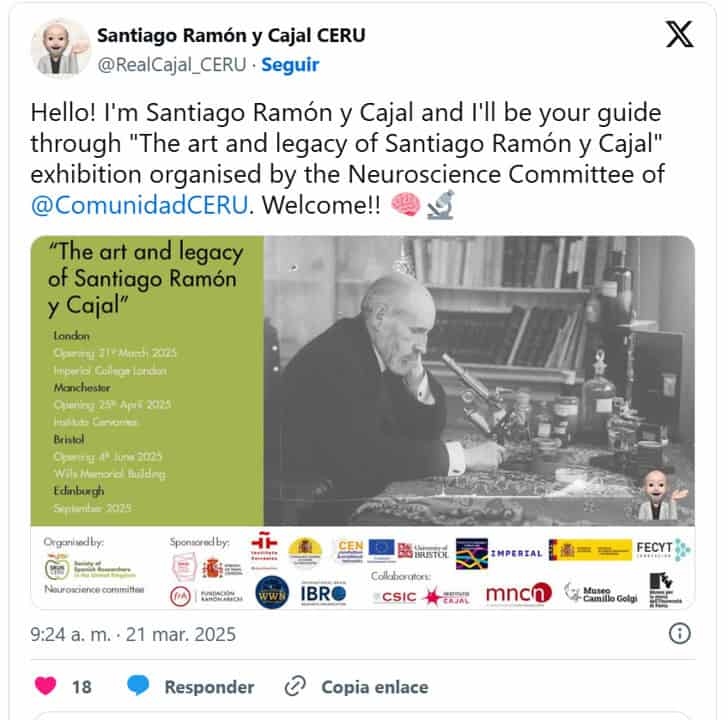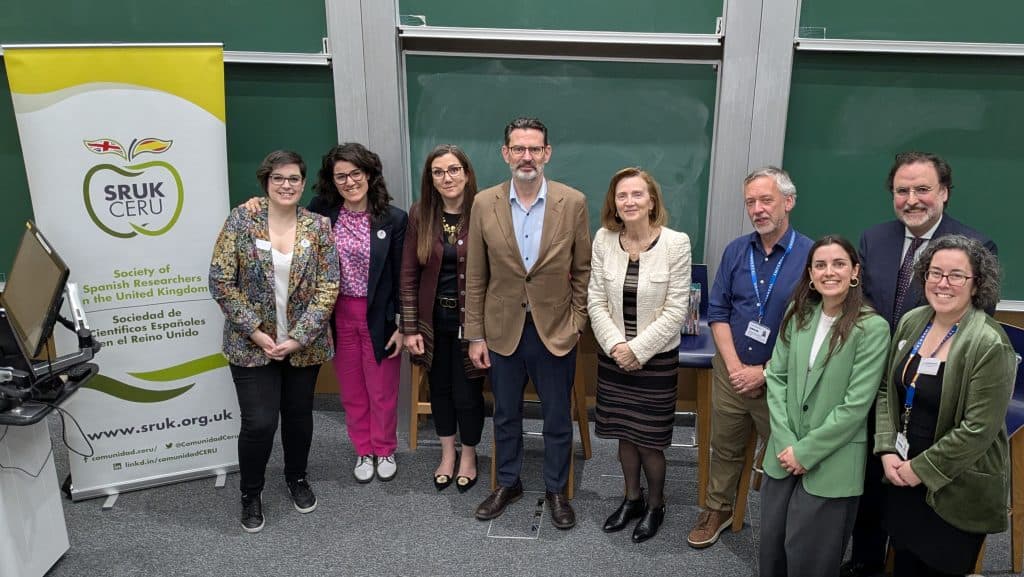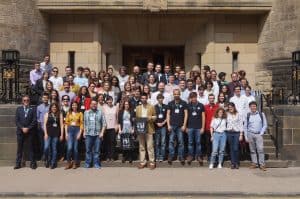- The traveling exhibition “The Art and Legacy of Santiago Ramón y Cajal”, organized by the Neuroscience Committee of the Society of Spanish Researchers in the UK (SRUK/CERU), was inaugurated yesterday at Imperial College London.
- The exhibition showcases details of the life, work, and relationship with the United Kingdom of the first Spanish researcher recognised with the Nobel prize through informational panels and his drawings.
- The exhibition will be open for free until April 11 at the Centre for Languages, Culture and Communication at Imperial College (South Kensington). It will then move on to Manchester (April 25), Bristol (June 4), York (July 4), and Edinburgh (September).
London, March 22, 2025
The Neuroscience Committee of the Society of Spanish Researchers in the UK (SRUK/CERU) inaugurated yesterday with great success the traveling exhibition “The Art and Legacy of Santiago Ramón y Cajal”, the first dedicated to the renowned Nobel Prize in Medicine in the United Kingdom. The event, held at the Centre for Languages, Culture & Communication at Imperial College London, highlights the life, legacy, and influence of Cajal on modern science, particularly in the field of neuroscience.
The exhibition, which will be open for free until April 11, offers a unique experience for the British public, who will be able to get closer to Cajal through the “tweets” from his account on X (@RealCajal_CERU). Visitors will be able to interact with Cajal, leaving comments and questions, creating a real-time dialogue with the pioneer of neuroscience. Additionally, QR codes placed on the panels will grant access to complementary online materials, expanding on the information available in the physical exhibition.

Divided into six key sections, the exhibition covers everything from the origin of Cajal’s legacy to his influence on contemporary neuroscience, including his family life, his impact on the United Kingdom, his role as a mentor, and of course, his historic Nobel Prize.
In her opening speech, Patricia García Jareño, Chair of the Neuroscience Committee of SRUK/CERU, highlighted that the main feature of the exhibition is Cajal’s drawings, selected to illustrate two fundamental theories he proposed: the neuronal theory and the theory of dynamic polarization. She also emphasized the inclusion of representations of dendritic spines, a key anatomical feature of neurons that Cajal was the first to describe. “We also showcase examples of different types of cells and brain regions to make visitors aware of the magnitude of his work,” she added.
The inaugural event gathered over 60 people, including prominent scientists, diplomats, and academics, who praised Cajal as a leading figure in modern science. Among them, Fernando de Castro (Instituto Cajal) opened the event with a lecture on how Cajal paved the way to understanding the brain, presenting his legacy both scientifically and artistically. Rosario Moratalla (Instituto Cajal) discussed the significance of Cajal’s research for understanding current neurological disorders, particularly anxiety and depression in neurodegenerative diseases.
Steve Gentleman (Imperial College London) emphasized the relevance of Cajal’s brain visualization techniques and his own work in developing technologies to study the 3D structure of the brain. Finally, Oscar Marín (King’s College London) shared his insights on the lasting impact of Cajal on modern neuroscience, underlining the importance of his discoveries related to the development of the cerebral cortex.

The exhibition will continue its tour across the UK with stops in Manchester (April 25), Bristol (June 4), York (July 4), and Edinburgh (September). In addition, various events and symposia on key neuroscience topics will be held in conjunction with the exhibition, such as the role of women in Cajal’s School and advances in cerebellum research.
The exhibition is free and open at CLCC Gallery, Centre for Languages, Culture and Communication, Level 3, Sherfield Building, South Kensington Campus, from 9:00 AM to 6:00 PM BST, until April 11.
Don’t miss this opportunity to delve into the fascinating legacy of a genius who transformed neuroscience.
“The Art and Legacy of Santiago Ramón y Cajal” is the result of the hard work of SRUK/CERU volunteers and has been supported and funded by the Embassy of Spain in London, the Spanish Foundation for Science and Technology (FECYT), the Ramón Areces Foundation, the Instituto Cervantes in Manchester, the Spanish Consulate in Manchester, the Cerebellum and Emotional Networks (CEN) project funded by the European Union, the University of Bristol, the Centre for Languages, Culture and Communication at Imperial College London, World Women in Neuroscience, the International Brain Research Organization (IBRO), the Spanish National Research Council (CSIC), the Instituto Cajal, the National Museum of Natural Sciences (MNCN), the Camillo Golgi Museum, and the History Museum of the University of Pavia.
Contact information:
Patricia García Jareño
Chair SRUK/CERU Neuroscience Committee
[email protected]





